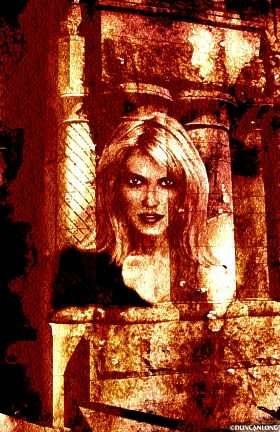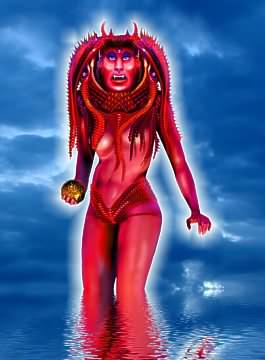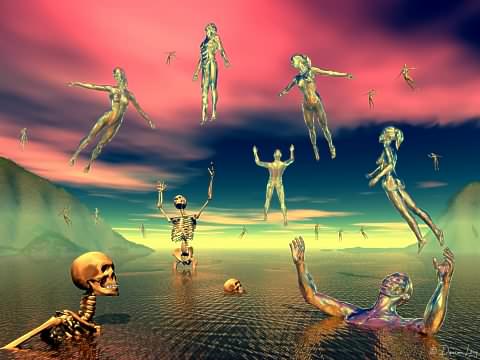|
|
The Apocalyptic Artwork of Duncan LongBy Emma AndrewsVisions of the ApocalypseFall 2006
However, Duncan Long, an emerging digital artist, proves this assumption wrong. His computer generated digital artwork based on the Book of Revelation is extraordinary, capturing the symbols and otherworldly imagery of St. John’s words like no other artist. Classified by some to be an outsider visionary, his different ideas and artwork on the apocalypse can be characterized as dispensational premillenialist. Some of his artwork seems to refer to the Book of Revelation even though he did not intend it to. Other pieces of artwork clearly identify verses in the scripture, but unconventionally represent John’s images. Duncan Long stands out among the vast majority of other apocalyptic artists in a unique way; Duncan Long is an artist who is still alive. He began drawing after being encouraged by his father. A self-taught artist, Long began producing books and illustrations, however, he pursued a Master’s degree at Kansas State University in music composition and became an art teacher. Eventually, he started to publish digital artwork in his self-written fiction stories. Thereafter, he produced artwork independent from his stories on a variety of themes such as society and religion. In addition to fictional stories, Long has written many non-fiction books about military small arms and survival. These include Survival Bible, Surviving Major Chemical Accidents and Chemical/Biological Warfare, and How to Survive a Nuclear Attack to name but a few. Long currently lives in Kansas and produces artwork, moonlights as an artist, ghostwrites as an author, composes music, and writes fantasy stories on his computer. Long comes from a very unique background. He is a descendent of a homesteading family in the Midwest. His grandparents did not enjoy the same luxuries that we enjoy today such as electricity, indoor plumbing, or finished flooring (Long, 2006). Long was raised in a town consisting of only 300 people, which two conservative churches represented. Throughout his life, many events took place in America that led many people to believe that the end was near. He cites prominent decades in his life characterized by apocalyptic fears; in the 80s, fear of an ecological crisis were rampant with people, believing, "we would run out of oil by 1980 and all be riding bicycles, that the world's over-population would lead to massive starvation by 1990, and that a new ice age was just around the corner to finish off those of us who chanced to survive the other problems." (Long, 2006). In addition, the Cold War and nuclear proliferation were a very real threat in Long’s early life. Combined with a religious belief in the apocalypse, secular fears about end times all compounded to convince Long that the apocalypse was a real and not too distant possibility. It has been argued by Dawn Glanz, a modern day apocalyptic scholar, that John’s colorful descriptions and symbols in Revelations have inspired artists to illustrate his apocalypse and reflect how the artists’ society adopts apocalyptic thinking. This reflection of apocalyptic imagery in a modern context shows how society tries to explain the past, present and its future (Glanz, 1982). Long’s artwork conveys both present day and futuristic aspects of the apocalypse. Based on Long’s articles and artwork, he could also be classified as a futurist. Long believes that it is now time to believe in Jesus Christ because the apocalypse is coming, however, he can be identified as a historicist because he lists biblical prophecies that have been fulfilled, which bases his belief on the coming apocalypse, (Long, 1996a). It would appear that while Long is an easy man to label, it is considerably more difficult to label him accurately. A glimpse at Long’s artwork and articles cannot clearly define him as a historicist or futurist because his style and views have evolved over his artistic career. For example, he once rejected the idea of the Rapture, but now accepts it based on Jewish and Greek literature. He exemplifies this belief through an article "Rapture or Tribulation," "It's an unfortunate fact that many Christians squander much of their time, failing to do little to further the kingdom of God or even to help their friends and neighbors avoid the wrath of the Tribulation, as well as the judgment that will follow it. Those who aren't Christians will be judged at the end of the Day of the Lord according to their works on earth; those found wanting, according to Revelation 20:15, will be "cast into the lake of fire" for an eternal second death," (Long, 1996b). Rapture is based on the Greek word Harpazo meaning to be taken up or snatched away. People who believe in the Rapture believe that at the end of the tribulation, the period of great suffering, Christians will be physically taken up into heaven while leaving non-Christians behind. Long’s views regarding literal interpretation of the book have also changed over time. He once thought of Revelation as symbolic, but now he believes that it is a realistic interpretation of eschatological events. He seems to lean more towards a balance between symbolism and realism. He dislikes the way that people interpret verses realistically to fit modernity. He also dislikes the fact that readers doubt that John’s depiction of otherworldly beasts and dragons and other such figures can happen because it discounts God’s supernatural omnipotent ability to make anything happen. Everything John writes about, according to Long, will occur because anything is possible (Long, 2006). Long explains that "I have no more trouble believing that this could be than I do believing that there might one day be a microbe discovered on Mars," (Long, 2006). His beliefs explain why his artwork is so fantasy-like, because in his interpretation, fantasies can come true. Long describes that he is unlikely to identify signs of John’s apocalypse with modern events, however, he believes that we may not be too far off if humanity provides the impetus for the end. Instead, Duncan Long believes that every human life faces its own apocalypse or end of times because we are mortal and must die one day (Long, 2006). Recognizing this may make anyone unreasonably weary of the end times or dangerously ignorant of them (Long, 2006). The important thing, according to Long, is to remember the fragility of life and be prepared to die, "whether in an apocalyptic holocaust or under the wheels of a bus I have had the misfortune to take a pratfall in front of," (Long, 2006). He characterizes himself as a person who once scrutinized events that may be contributing to the end of times; however, he is now more relaxed, relying on God’s will to initiate the end. Long is a self-identified outsider visionary artist due to the awe-inspiring surrealism of his artwork. The striking feature of outsider art is that it presents a world in transcendent or metaphysical terms and is often produced by the psychotic or mentally handicapped. Images reveal things that would otherwise remain hidden and artists develop their own cosmology (Rhodes, 2000). Similarly, Long describes that his creative process is not always well planned in advance. Ideas leap onto the canvass without prior thought. Long confesses that when he creates his artwork, he sometimes cannot identify why images make it into his artwork or what they mean, "A robot playing a violin might appear. I create it and then pin a name to the illustration. But what does it really mean? Is there some subconscious meaning there that I don't even recognize? Is it a veiled comment on our culture, so deeply buried in the collective consciousness, that even the artist is unaware of what it means? Or was it simply generated by the odds and ends of the day like a dream that has no meaning?" (Long, 2006). As Long personally illustrates, outsider visionaries are not always the crazy and deranged, rather they are sometimes normal artists with grandiose yet inexplicable visions. Indeed, visionary art is not just produced by those who are psychotic. Alternative reasons may underlie the artists’ separation from dominant culture. Artists can be set apart from an audience because of cultural identification or different religious beliefs (Rhodes, 2000). This may be the case with Duncan Long, whose religious and cultural beliefs about the end of times could possibly differ from the common person. Some may even label him iconoclastic because of his unconventional artwork dealing with Revelations. However, his supernatural fantasy-like artwork may even be considered mainstream in a society that produces movies such as Lord of the Rings and Harry Potter or plays highly imaginative games such as Dungeons and Dragons. By displaying and selling his artwork via the internet, Duncan Long has used a modern technology to create and market artwork much like fellow apocalyptic artist Albrecht Durer took advantage of the printing press for mass production. Like the printing press, digital artwork is a revolutionary medium and an important opportunity for smaller independent artists to gain in popularity. Digital art is created on a computer. It can be created through vector graphics software by using a graphics tablet. The art can either be two- or three-dimensional. Long’s is produced using a tablet stylus or a mouse instead of a pencil or paintbrush. Images appear to be drawn on paper, however all the work is done through a computer. This allows the artist to change and perfect the image to his or her liking unlike conventional artwork. The difference between traditional and digital art has actually merged now that the two media can be and often are combined (Paul, 2003). Long is a stellar example of this change from sketch pad and canvas to digital. He actually started doing artwork with pens, brushes and paper, but switched to computer-generated art because of its convenience (Long, Duncan’s Art Frequently Asked Questions (and Answers)). Digital artwork is not only convenient; it adds another dimension to artwork because different mediums such as photography, sketching, and painting can be easily combined thereby simulating a new and bold reality (Paul, 2003). It also challenges norms of realism by creating an aura of hyperrealism that is neither artificial nor authentic; it thus effectively alters and questions how the world presents something (Paul, 2003). Long’s work achieves this because it is symbolic yet realistic at the same time; Long’s work could best be described as realistic symbolism. Long states that, "perhaps one of the oddities of a visual medium [is] that it deals with both ideas and actual scenes, often in the same picture," (Long, 2006). For example, in Long’s "Mark of the Beast," most people do not have UPC labels on their foreheads in reality yet they may feel attached or an effect of some kind of societal mark. Long’s artwork illustrates the realistic symbolism of digital artwork while shedding light on his religious upbringing and apocalyptic views.  Duncan Long’s "Mark of the Beast" is an interesting social commentary of modern times that fits into St. John’s context well. The image features the facial close-up of a man and a woman with UPC codes on their foreheads surrounded by a fiery background. The first three numbers on the codes read 666 above faces whose expressions read nothing by negativity. This image follows John’s apocalypse closely. It corresponds with the description of the Beast whose name is the number 666, "he has also forced everyone, small and great, rich and poor, free and slave, to receive a mark on his right hand or on his forehead, so that no one could buy or sell unless he had the mark, which is the name of the beast or the number of his name," (Rev 13:16-18). The UPC or the Universal Product Code label invented by George J. Laurer in 1973 is a modern depiction of John’s words because it is an automated way of checking out products, (Morton, 1994). It facilitates quick and easy trade in capitalist societies, which arguably could not function as efficiently without the UPC code’s ability to track and identify products amidst the millions of different commodities on the market. Therefore, Long’s image may be a social critique of the capitalist Beast in modern society that urges the commercialization of goods and people. Featuring UPC codes that read 666 on the people’s foreheads is a rather Marxist and/or Orwellian way of interpreting John’s Revelation.  Another image Long created that reminds the viewer of the Book of Revelation is "An Ancient Theme." This image features a background of Doric pillars, perhaps the ruins of Roman architecture, with the head shot of a blonde woman making a lascivious facial expression. Her image blends into the architecture as if she were infinitely part of it. To one familiar with the Book of Revelations, this image may bring to mind a modern day representation of the Whore of Babylon, due to her modern hairstyle and make-up. Interestingly, Long states that he did not have the Whore of Babylon in mind when he created the image. Instead, he wished to show the fact that sin has been embedded in cultures since ancient times, (Long, 2006). Similarly, John criticizes Roman and Babylonian society by featuring the Whore of Babylon who entices the kingdoms into sexual relations with her through the pursuit of riches and tyranny. John says that she is "the great city that rules over the kings of the earth," (Rev 17:18). Book of Revelation scholars claim that John uses sexual imagery to depict how Rome attracted many nations to enter political and commercial alliances, which were irresistible because of its power and wealth (Reddish, 2001). Babylon entered into such an alliance and therefore shared in Rome’s sinful and cultural fornication against God (Reddish, 2001). John uses female imagery because it shows how adultery is committed against God, and because cities were frequently depicted as women in ancient times, (Reddish 2001). Because Long uses a female face instead of a male one, the image’s audience can infer that the woman could be the Whore of Babylon. In addition, it demonstrates the realistic symbolism that Long often portrays in his work with a human face etched into architecture. The contrasting modernity with historical allusions fits into his futurist/historicist point of view with an interesting social commentary.  In contrast to "An Ancient Theme," Long created an image entitled, "The Whore of Babylon," which concretely tells the audience that he means to present John’s Whore of Babylon. However, unlike "An Ancient Theme" in which the viewer can guess the meaning of the image without the title, "The Whore of Babylon" is not easily identified as John’s Whore of Babylon. John describes the Whore of Babylon as "...a woman sitting on a scarlet beast that was covered with blasphemous names and had seven heads and ten horns. The woman was dressed in purple and scarlet, and was glittering with gold, precious stones and pearls. She held a golden cup in her hand, filled with abominable things and the filth of her adulteries. This title was written on her forehead: MYSTERY BABYLON THE GREAT THE MOTHER OF PROSTITUTES AND OF THE ABOMINATIONS OF THE EARTH. I saw that the woman was drunk with the blood of the saints, the blood of those who bore testimony to Jesus," (Rev. 17:3-6). In contrast to the biblical text, Long depicts the Whore of Babylon as an otherworldly Medusa. She wears red scaly underwear to accompany her scaly headdress and horns. Her body has a magenta glow, but no sign of purple, the color of royalty. Instead of a golden cup in her hand, Long’s Whore of Babylon appears to be holding a piece of golden fruit. It could be a reminder of Eve’s stolen fruit in the Garden of Eden. Long’s image does not depict the whore with precious stones, pearls, or gold. She is not riding a beast with seven heads and ten horns either, however, she does wade in water, which is similar to John who states, "The waters you saw, where the prostitute sits, are peoples, multitudes, nations and languages," (Rev 17:15). This line symbolizes the fact that Rome controls the world. Perhaps Long similarly tries to imply that some monstrosity in the world controls life. Clearly, Long has his own very unique artistic ideas and interpretations of the scripture.  Finally, Long’s image "Rapture" exemplifies Long’s belief in the Rapture. "Rapture" features men and women along with skeletons ascending into the air from land and water. It seems that the skeletons represent the dead. The translucent men and women are the souls ascending into heaven who have recently transformed from the skeletons of dead bodies. Long’s belief in the rapture is based on his dispensational premillenialist views. Dispensational premillienialism is the belief that Christ’s return will come before the millennium and will rapture the faithful living and dead into heaven. After this, there is the tribulation, a seven-year period in which the antichrist rules the earth. At this time, the Jews rebuild the temple in Israel. When the tribulation ends, a battle of Armageddon ensues in which Christ comes again to reign for a 1000-year period. At the end of this time, Satan is freed and he attacks Christ’s kingdom, but loses. Ultimately, the final judgment separates the believing and non-believing, (Reddish, 2001). It is unclear as to which millennium the scriptures refer to, but Long and others who hold this view believe it will happen soon. According to Long, the tribulation period is at hand because it occurs during a peace period, which he believes is represented by the 1996 cessation of hostilities between the Palestinian Liberation Organization and Israel. This is foretold by 1 Thessalonians 5:3, "for when they shall say peace and safety then sudden destruction shall come upon them as birth pains upon a woman with child and they shall not escape." After this, Matthew 24 and Revelation 6 explain that sorrows will befall the earth such as earthquakes, pestilence, and war. The invasion of Gog into Israel is the war that marks the beginning of the Great Tribulation. Identifying a date for all of this to commence is difficult, however Long believes that the rapture will happen on the 24th day of the Hebrew month Kislev. This is because Haggai 2:18 states that "from this day and upward, from the four and twentieth day of the ninth month, even from the day that the foundation of the Lord's temple was laid," the rapture shall begin. According to Long, on Hanukkah, Christ said to the apostles that he will allow his followers to have eternal life, "and they shall never perish; and no one shall snatch them out of My hand," (John 10:28). This is interesting because Hanukkah falls on the 25th day of Kislev, the day after Haggai suggests the rapture will begin, and the day celebrating the day after the Jews regained the temple from the Syrian Greeks (Long, 1996c). Since Jesus mentions that no one will snatch up or rapture his followers up but him on Hanukkah, it may be further reinforcement of the 24th day being the tribulation commencement, but it is still unclear what year this may happen (Long, 1996c). Long believes that the Rapture shall take place on Rosh Hashanah because on this holiday, a trumpet was blown at the end of the feast to signify the raising of the dead and the beginning of a new year. It was also blown when war was about to commence (Long, 1996c). This last trumpet idea is paralleled in 1 Corinthians 15:51-52 "Behold, I show you a mystery: We shall not all sleep, but we shall all be changed, in a moment, in the twinkling of an eye, at the last trump; for the trumpet shall sound and the dead shall be raised." Because this blowing of the trumpet may rapture the dead and mark the beginning of battle, it fits Long’s idea that the rapture and initiation of the Great Tribulation might occur simultaneously. The rapture and the Great Tribulation must occur soon, according to Long, because the Great Temple’s reconstruction in Israel is nearing completion (Long, 1996c). These beliefs label Long as a dispensational premillienialst and show that he has thought about the timing of these events. Therefore, representations of the Rapture in his artwork are characteristic of his belief and are his vision of what may soon occur. Long also references several theologians that he bases his beliefs on. They are Hal Lindsey, Grant Jeffrey, and Jack Van Impe. Jeffrey believes that the end is coming and will play out with God punishing the radical Muslims because of their Jihad against the West. He believes the "bible demonstrates supernatural knowledge of the future," (Grant Jeffrey Ministries, 2004). Jack Van Impe also believes that the Book of Revelation depicts what will actually happen. He has a timeline of apocalyptic events that have yet to come. In addition he has a "Middle East invasion map," an analysis of potential invasion routes and scenarios according to how the bible states the "Battle of Armageddon" will occur, (Jack Van Impe International Ministries, year not listed). These sources are futurist. Jack Van Impe’s beliefs about the Battle of Armageddon are characteristic of dispensational premillienialism. These theologians were the basis for the Left Behind Series, however, Long finds fault with the series and does not take it seriously. On the other hand, these theologians seem to reflect Duncan Long’s views on the apocalypse. Duncan Long is an enigmatic artist in terms of his beliefs and creation. He has used a revolutionary medium, digital art, to market and produce his work. His style and beliefs are continuously evolving from symbolic to realistic, juxtaposed with John’s Book of Revelation. Throughout his life, he has been studying the apocalypse and reformulating ideas. His dispensational premillenialist views assert that the Rapture and Tribulation are close at hand. Amidst this, he also illustrates and re-emphasizes John’s social commentary on sin in the ancient and modern world through his work, "An Ancient Theme," and our slavery to money and wealth through "The Mark of the Beast." Nevertheless, he sometimes realistically yet symbolically depicts scenes from John, which are shown in the unique fantasy-like depiction of "The Whore of Babylon." Most interesting of all and perhaps a true characteristic of all art, Long expresses that beauty and meaning are in the eye of the beholder. Long would create artwork based on the Book of Revelations and the Rapture even if he did not believe any of it. This means that an audience’s interpretation of any artwork is subjective unless the artist is on hand for an interview. Due to his intriguing, insightful, intrepid, and beautiful artwork, Duncan Long deserves consideration among the many historic examples of apocalyptic artist around the world. He has brought apocalyptic art into the new millennium and all that remains to be seen is how far he, his work, and humanity may go. About the author: Emma Andrews is a senior environmental studies major at Dickinson College in Carlisle, Pennsylvania. Her paper was part of a class assignment for "Visions of the Apocalypse," a class aimed at studying John's Book of Revelation and how it has been depicted in artwork throughout time. Her interest in the subject is primarily due to the fact that environmental degradation is an apocalyptic event; however, the class has helped her develop a better understanding of eschatology and how it helps shape beliefs about the End Times. Her thesis focuses on the meaning behind Duncan Long's apocalyptic artwork and how it relates to his religious beliefs and artistic background. Bibliography: Alan Q. Morton (1994). "Packaging history: The emergence of the Uniform Product Code (UPC) in the United States". History and Technology 11 (1): 101. Binkley, Timothy. "The Vitality of Digital Creation." The Journal of Aesthetics and Art Criticism 55(1997): 107-116. Just, Felix. "Apocalyptic Art by Duncan Long." 03 Oct 2006. Christian Art. 25 Oct 2006, http://catholic-resources.org/Art/DuncanLong.htm. Glanz, Dawn. "The American West as Millenial Kingdom." The Apocalyptic Vision in America. ed. Lois Parkinson Zamora. Bowling Green, Ohio: Bowling Green Univeristy Press, 1982. Jeffrey, Grant. "Prophecy Online." 2004. Grant R. Jeffrey Ministries. 24 Oct 2006 http://www.grantjeffrey.com/index.html. Long, Duncan. "Duncan's Art Frequently Asked Questions (and Answers)." No year listed. 24 Oct 2006 http://duncanlong.com/science-fiction-fantasy-art/faqs.html. Long, Duncan. E-mail interview. 15 Nov 2006. Long, Duncan. "Are We Nearing the End Times?" 1996a. 24 Oct 2006 http://duncanlong.com/science-fiction-fantasy-short-stories/olympics.html. Long, Duncan. "Rapture or Tribulation." 1996b. 24 Oct 2006 http://duncanlong.com/science-fiction-fantasy-short-stories/rapture.html. Long, Duncan. "The Rapture, Gog, and Hanukkah Puzzle: Putting It All Together." 1996c. 24 Oct 2006. http://www.duncanlong.com/science-fiction-fantasy-short-stories/gog.html. Paul, Christiane. Digital Art. London, Thames and Hudson Ltd.: 2000. Reddish, Mitchell G. Smyth and Helwys Bible Commentary: Revelation. Macon, Georgia, Smyth and Helwys Publishing Inc: 2001. Rhodes, Colin. Outsider Art: Spontaneous Alternatives. London, Thames and Hudson Ltd.: 2000 Van Impe, Jack. "Bible Prophecy Portal of the Internet." Jack Van Impe Ministries International. 24 Oct 2006 http://www.jvim.com/. Text Copyright © 2007 by Emma Andrews. Illustrations Copyright © 2007 by Duncan Long. All rights reserved. Text used with permission of the author. Copying of this article or illustrations is strictly prohibited without prior written approval of the copyright owner.
Duncan Long's Home Page
Duncan Long's Online Gallery
|
 Nowadays, contemporary Christian artwork is difficult to find with so much emphasis on early renaissance and medieval artists. That is why it is surprising to find artists making digital graphic Christian art inspired by the Book of Revelations. In contemporary apocalyptic art and literature, much emphasis is given to issues such as nuclear proliferation, Y2K, and global warming; however, not very many people recognize the Book of Revelation and other biblical texts as being on the forefront of portraying "what is to come."
Nowadays, contemporary Christian artwork is difficult to find with so much emphasis on early renaissance and medieval artists. That is why it is surprising to find artists making digital graphic Christian art inspired by the Book of Revelations. In contemporary apocalyptic art and literature, much emphasis is given to issues such as nuclear proliferation, Y2K, and global warming; however, not very many people recognize the Book of Revelation and other biblical texts as being on the forefront of portraying "what is to come."